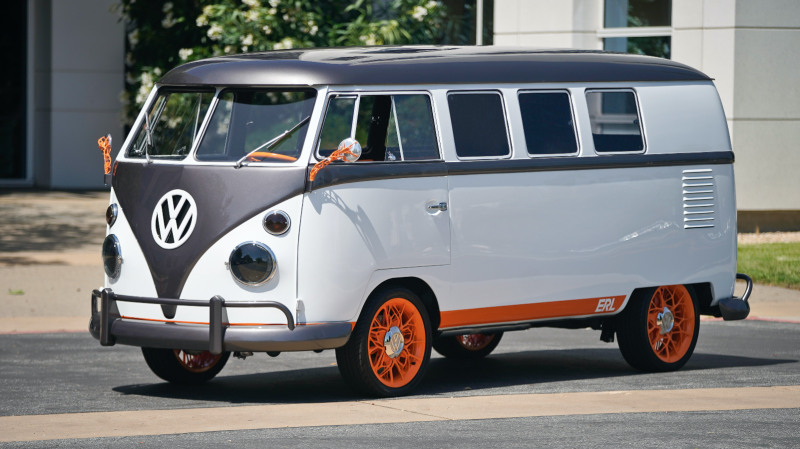
Volkswagen’s California-based Electronic Research Laboratory has been re-named the Innovation and Engineering Center California (IECC), and has been given an expanded role in the company. So, to celebrate, they did the only rational thing they could do: they took a 1962 Type 2 11-window Microbus and re-worked it into an electric vehicle crammed with high-tech toys and a strange but interesting biology-inspired design motif.
The resulting bus is called the Type 20, and while the fundamental body has remained unchanged and classic(save for restoration and paint), everything inside and bolted to it is pretty cutting edge.

The original 42 horsepower 1500cc air-cooled flat-four was replaced (I mean, it was likely gone long ago, I bet) with a 120 horsepower electric motor that produces 173 pound-feet of torque. The motor is powered by a 10 kWh battery, and I don’t think anyone has bothered to figure out the range just yet.
Advertisement
Porsche helped to design the Type 20’s novel active pneumatic suspension system, which can dynamically adjust the ride height. It’s set up so that the bus raises up when it detects the driver approaching, which I suppose also suggests it settles down low when parked, like an old Citroën DS.

Advertisement
It’s also got a face recognition system with the necessary cameras to identify drivers and passengers, which is only a little creepy, and has a voice-activated digital assistant, with microphones by the cockpit, passenger area, and even an external mic. The headlights and LED-illuminated VW logo provide visual feedback when you’re talking to your car outside of it.

Advertisement
They’ve also integrated a Looking Glass II holographic display on the dashboard, but so far no word if you can play monster chess on it, like you would on the Millennium Falcon.

Advertisement
The visual design choices made for the concept are interesting; they clearly wanted to keep the fundamental and iconic Microbus look intact, and they did that, retaining nearly all of the key details and trim, including especially vintage parts like the bumpers and overriders.

Advertisement
The orange-white/gray-black color scheme works well, I think, and there’s lots of fun eye candy here, especially in the way they’ve made the engine compartment into an illuminated, minimalistic showcase, including an extra window on top so you can look down into it from the rear cargo area.

Advertisement
The biomorphic design motif used on the wheels, side mirror supports, under seat supports, steering wheel, and other places in the Bus don’t necessarily fit with the original Microbus design vocabulary, and while they never really integrate with the original aesthetic, they work with it in a compelling way.

Advertisement
The orange tendrils feel like tree roots or nerve fibers, growing and infesting the Bus, and that’s sort of a fitting metaphor for what’s going on here: an old, iconic design, with new technology growing into and onto it, like vines covering an old house, with the original structure still visible, but simultaneously taken over by the relentless grasp of biology.

Advertisement
It’s clear that Volkswagen is going all-in on their Type 2 history as a prelude to their upcoming EV re-born Microbus, the ID Buzz. It’s an EV I’m excited to see happen, and I think VW is at its best when they’re not afraid to explore and mine their heritage, so I’m all for all the interesting resto-mods that VW is willing to crank out.
Even with a lot of plant-alien-looking details.













